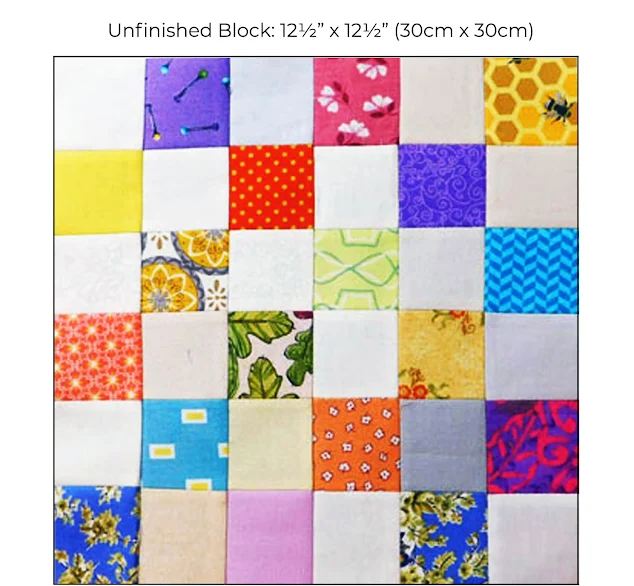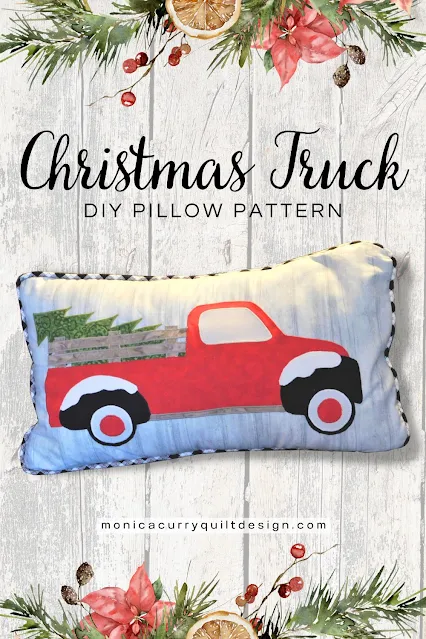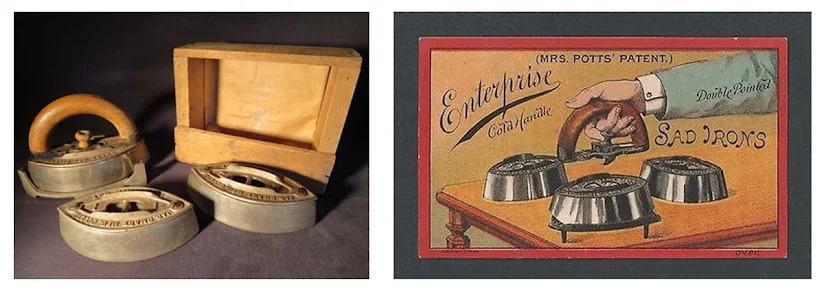Make Super Easy Checkerboard Blocks - SCRAP BUSTER!
INSTRUCTIONS
I discovered this technique for making scrap checkerboard blocks several years ago. I used it to make my grand-niece a doll quilt (above). With these few easy steps, the results are so worth it. When you're finished, every square will be aligned perfectly and you'll have a strong base to join the blocks so they won't stretch out of shape.Finished Block: 12"x 12" (30 cm x 30 cm))
1. First, you'll need a non-woven, lightweight, single-sided fusible interfacing. I purchased this very inexpensive one on Amazon.
2. Cut [18] 2½-inch (6 cm) colour squares and [18] 2½-inch (6 cm) light colour squares.
3. Cut [1] 13" x 13" (31 cm x 31 cm) square of interfacing.
4. Place squares 1/2" from the edges on the adhesive side of the interfacing. Butt together the squares as shown below alternating between light and dark colours.
5. Place a piece of cotton over the squares and press to adhere them to the fusible web.
6. Fold the first row right sides facing and sew a "fat" 1/4" seam allowance. Repeat this until all the rows are stitched.

7. Your first set of rows will look like this.
8. Trim a about 1/8" off the edge of each seam row and press seam open. Be very careful to not cut the stitches!

9. Stitch the horizontal rows and trim the seams the same as you did with the vertical rows.
10. Press down all your seams. This is what your stitched squares will look like from behind.
Little Red Truck: A Christmas Classic
I'm not a vintage car enthusiast, but I love old trucks. I think this Little Red Truck is one of my cutest appliqué patterns yet. The finished pillow measures 20" x 12" and has a envelope back. The piping finishes it off nicely but this is optional. If you love the look of piping but not sure how to do it, the pattern has a link to a video tutorial on how to make and add piping to a pillow.
The more things change . . .
. . . the more they stay the same.
I bought the older iron at my favourite antique shop. It's a Mrs. Potts Cold Handle Sad Iron. The "sad" in sad iron is from the Middle English word sad which meant solid or heavy.
The second iron was a Panasonic Cordless 360° Freestyle™ Steam/Dry Iron. This iron is so similar to the Sad Iron I suspect the designers at Panasonic really knew their clothes iron history.
In 1871, at 19 years old, Mrs. Potts patented the Cold Handle Sad Iron changing the clothing iron industry forever and making her one of the most famous woman of her time. The wooden handle stayed cool for ironing and was detachable so that the user could keep several iron bases on the stove at one time then switch to a new hot iron when the first iron cooled.
I bought two irons this month that were manufactured over 100 years apart and was intrigued by how similar they were in design. Both have a double point base, a rounded handle, and need to be placed on a heat source before ironing. The technology for each iron was vastly different, but the concept was the same.
I bought the older iron at my favourite antique shop. It's a Mrs. Potts Cold Handle Sad Iron. The "sad" in sad iron is from the Middle English word sad which meant solid or heavy.
Who is Mrs. Potts and What is a Sad Iron?
Mrs. Potts was born Mary Florence Webber in 1850 in Iowa, US. When she was 17 she married Joseph Potts who was a Civil War veteran 17 years her senior.In 1871, at 19 years old, Mrs. Potts patented the Cold Handle Sad Iron changing the clothing iron industry forever and making her one of the most famous woman of her time. The wooden handle stayed cool for ironing and was detachable so that the user could keep several iron bases on the stove at one time then switch to a new hot iron when the first iron cooled.
The Sad Iron Kit
When Sad Irons came on the market in the late 1800s the Mrs. Potts Sad Iron Set sold for a whopping 0.70 cents! The set came with three iron bases, a detachable wooden handle, and a trivet. You could also buy the bases separately if you needed more.
Sad Irons were used well into the 1940s; mainly because some rural communities still didn't have electricity. The Sad Iron was manufactured until 1951.
Sad Iron Trading Cards
Trade cards were a very popular form of advertising in Victorian times and thousands were used to advertise the Potts' Sad Iron. The cards were quite comical and sometimes quite racist.
THE CHILDREN CRY FOR IT
I guess the message in this trading card is"So easy a child can use it." Sure. What could go wrong?
 |
| GIRL: "Oh Ma! I want to stay home and iron, this new iron is so nice." MOTHER: "What? Not gone to school yet. You'll catch it." |
MRS. POTTS IRON VS THE THERMOMETER
Not sure what the message is in this trading card.
Maybe the woman loves using her new Sad Iron so much
she's heating up the house with it? How much ironing does this woman have?!
Maybe the woman loves using her new Sad Iron so much
she's heating up the house with it? How much ironing does this woman have?!
 |
| HUSBAND: "Gracious! Do stop ironing. I am sweating fearfully just sitting here." WIFE: "Well dear, you know I use those Mrs. Potts' Cold Handle Sad Irons and I am just delighted with them." |
THE WATERMELON SEASON AT BLACKSVILLE
Blacksville?!
This trade card suggests using the Sad Iron as a compress for a
child's stomach ache?! And it's racist AF!
child's stomach ache?! And it's racist AF!
 |
| WOMAN: "Ah Chile. Yous bin eatin' dem watermillyons. Come yere honey. I'll just put dis ere Mrs. Potts' Iron to yer stomach. It retains de heat and an will help yer. Dis season is bad for the chillum." |
I'm finally a member of the 241 Tote Club!
This is the 241 Tote by Noodlehead. I've been meaning to make this cute bag for a couple of years now and finally finished it this summer. It was a fun bag to make. The 241 Tote is all over Pinterest so there's no shortage of fabric ideas for it. I would say the pattern is for people with some bag making experience, but it really isn't too difficult.
Why is it called the 241 Tote? Anna Graham (Noodlehead) explains the pattern's name.
"It's called the 241 Tote because it's like two patterns in one (two for one)! One version of the bag has two exterior side pockets (great for beginners), the other has two exterior zippered pockets (for those who might want a bit of a challenge)."
The fun part was picking out the fabrics. I decided I wanted this bag to be as bright and as cheery as possible. I believe I accomplished that 😊. These bright fabrics were in my scrap bin and I was happy I could finally use them for something.
Subscribe to:
Posts (Atom)



.jpg)





















